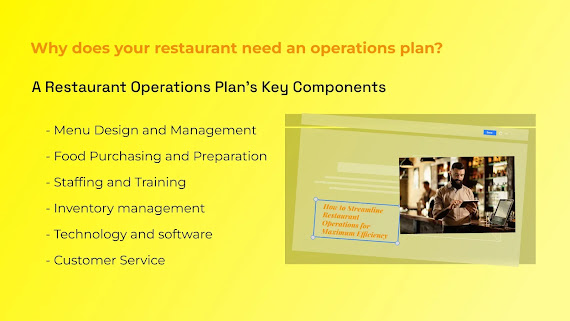How to Streamline Restaurant Operations for Maximum Efficiency
Understanding Restaurant Operations: A Holistic Overview
Restaurant operations encompass the intricate web of tasks that keep a dining establishment running seamlessly. From service to food preparation, each aspect plays a crucial role in meeting customer demands. For sustainable success, efficient oversight of these components by management or owners is imperative.
The Indispensability of an Operations Plan for Your Restaurant
Many restaurants face premature closure within their first year, often due to the absence of a robust operations plan. Recognizing the pivotal role operations play is crucial. Here's why an operations strategy is paramount for your restaurant:
Cost Reduction and Profit Increase:
Clearly defined operations minimize costs, cut food waste, and offer avenues for profit augmentation.
- Consistent Services: Standards set through an operations plan facilitate consistent service delivery across various facets of the business.
- Emergency Preparedness: An operations plan aids in planning for and handling emergencies, ensuring the resilience and security of the establishment.
- Enhanced Communication: Operations set a tone of individual responsibility and accountability, mitigating communication issues that can lead to employee dissatisfaction.
Important Components of a Restaurant Operations Plan
Embarking on the creation of your restaurant's operations plan? Ensure it includes these key elements:
- Menu Design and Management: Showcase a sample menu to help investors grasp your product offerings. Focus on a limited, cost-effective menu with locally sourced ingredients.
- Food Purchasing and Preparation: Define the food purchase and preparation process to manage inventory expenses. Strike a balance between fresh and long-lasting ingredients. Implement recipe cost cards for consistency and quality.
- Staffing and Training: Identify precise staffing needs to make informed hiring decisions. Outline full-time and part-time hiring plans and associated salaries. Detail a comprehensive training program for both front- and back-of-house staff.
- Inventory Management: Conduct market research to devise an efficient inventory management strategy. Specify restocking frequency, storage costs, suppliers, and tracking methods.
- Technology and Software: Provide a summary of technological tools like reservation systems, inventory management, and payment systems. Investigate competitors' technology usage to stay abreast of industry standards.
- Customer Service: Develop strategies for continuous quality service, addressing aspects like queue management, food quality, complaint resolution, and digital payment options.
Optimizing Restaurant Operations: Strategies for Success
Efficiently maximize your restaurant operations with the following strategies:
Simplify Your Operations:
Streamline menu options and staffing to reduce costs and enhance efficiency.
Utilize inventory software for automation, freeing up staff time for essential responsibilities.
Create Explicit Guidelines:
Establish clear, standardized guidelines for each operational aspect.
Use manuals and checklists to ensure transparency and consistency.
Gather a Variety of Feedback:
Seek feedback from internal stakeholders on the effectiveness of existing standards and procedures.
Collect customer feedback to assess front-of-house operations and identify areas for improvement.
By embracing these strategies, your restaurant can not only survive but thrive in a competitive culinary landscape. Strive for simplicity, clarity, and continuous improvement to create an environment that delights both customers and staff. Cheers to the success of your restaurant!



Comments
Post a Comment